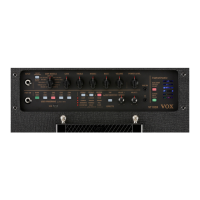
Do you have a question about the Vox VT100X and is the answer not in the manual?
| Amplifier Type | Modeling |
|---|---|
| Power Output | 100W |
| Footswitch I/O | 1 x 1/4" (footswitch) |
| Amp Models | 33 |
| Outputs | 1 x Headphones |
| USB | Yes |
| Speaker | 1 x 12" Vox Custom |
| Inputs | 1 x 1/4" |
Port for connecting your guitar to the amplifier.
Controls for selecting amp models and adjusting core tone parameters.
Adjusts the output level of the power amp while maintaining distortion.
Controls for managing and recalling user-created programs and foot switch connection.
Controls for selecting and adjusting modulation, delay, and reverb effects.
Connect an external audio device to play along with music.
Output for headphones or direct connection to recording devices.
Controls for adjusting tube bias and class operation for tonal shaping.
Turns the amplifier's power on and off.
Port for connecting the amplifier to an AC power source.
Recalling pre-programmed sounds based on specific amp models.
Using the amp like a conventional guitar amp with direct knob control.
Recalling user-saved programs via bank and channel selection.
Controlling bank and channel selection with the foot switch.
Using the foot switch for tap tempo and effect on/off.
Models a dual channel, 22W blackface 60's design with tube-driven spring reverb.
Models a 4x10" combo amp from 1959 known for its smooth, crisp overdrive.
Models the Normal channel of the AC30, delivering a captivating clean sound.
Models the overdrive channel of a special order amp known for sustain.
Models an AC30 with the 1964 'top boost' circuit, offering deep overdrive.
Models a 1983 British 100W head for thick, snarling hard rock and metal sounds.
Models a British 100W head with two channels for classic rock to high-gain.
Models a modern high-gain channel ideal for low tunings and metal.
User-programmable model based on a special order amp's clean channel.
User-programmable model based on a classic 60's British hand-wired head.
User-programmable model for crushing high-gain sound, ideal for drop tunings.
Models a compressor for clean, percussive, and mellow sustain.
Models a classic lush analog chorus unit.
Models a well-known overdrive pedal for its remarkable warmth.
Models a classic Japanese-made distortion unit.
Models a classic analog flanger associated with guitarists.
Models a popular analog phaser in an orange box.
Models the tremolo circuit built into a classic American amp.
Simulates a typical room with numerous early reflections.
Simulates the spring reverb found in many guitar amps.
Models reverberation and echo of a large concert hall.
Models a classic plate reverb unit found in recording studios.